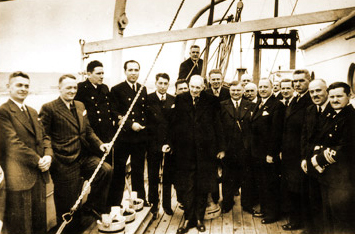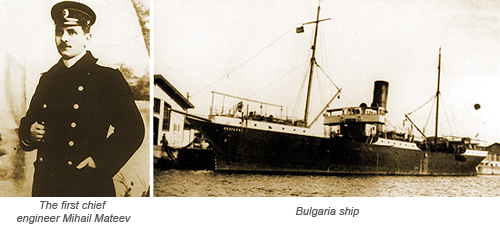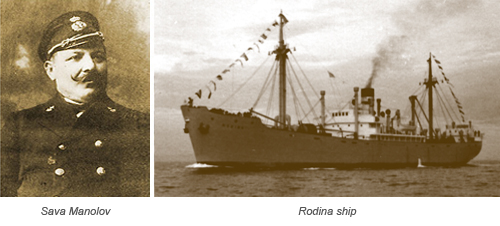
31 December 1889. At the New Year’s Eve six Varna
proprietors Veliko Hristov, Yanko Slavchev, Petar Enchev, Ivan Manzov,
Stat Panitsa and Petar Popov summoned a meeting and set up a Commission
which drew the draft of the Articles of Incorporation of the future
company.
21 January 1890. The Commission presented the draft
in the Ministry of Finance for approval. This is considered as the
first page of the long Bulgarian Steamship Company history.
25th July 1892. The First constituent meeting of the
shareholders in the Bulgarian Steamship Company was summoned. 25th
November, 1892 the Council of Ministers approved the statute of the
Company and 14th December, 1892 the Bulgarian Parliament passed a "Law
for the Establishment of Bulgarian Steamship Company on the Black Sea,
seated in Varna".
15th August 1893. The first general meeting of the
shareholders was summoned. The newly elected Managing Board of Directors
adopted a resolution for the purchase of the first two steamships of
the Company.
August-September 1894. The Bulgarian steamships
"Boris" (869 GRT) and "Bulgaria" (1108 GRT), built in the UK arrived in
Varna. They operated between the Bulgarian ports and the eastern part
of the Mediterranean Sea.
1903 - 1906. The steamships "Varna" (1820 GRT), "Sofia" (255 GRT) and "Kiril" (509 GRT) were delivered.

1907. The foreigners in the officers staff on the
vessels of the Company were replaced mainly by Bulgarians. Sava
Manolov, Varban Chervenkov, Petar Abadzhiev became the first masters,
and Mihail Mateev - the first chief engineer.
1912-1913. The crews on board the vessels of the
Company took active part in the support of the Bulgarian Army and the
Navy during the Balkan War.
1913. The steamship "Tzar Ferdinand" (1994 GRT) was delivered from Italy.
1916-1918. The vessels of the Company took active
part in the First World War. The vessels were mobilized. Apart from
transportation of military goods, these were used as mine sweepers and
floating supporting units for submarines and navy aviation.
1928. The first commercial vessel "Bourgas" (2941
GRT), equipped with radio transmission device, built in Italy in 1900
was delivered.
1931. The vessels of the Company carried 65 755 t of cargoes and 26 321 passengers.
1933. The steamship "Balkan" (3838 GRT), built in 1911 in France was delivered.
8th December 1933. The steamship "Princess Maria
Luisa" (3821 GRT), built in France in 1919 was delivered. Together with
"Balkan" they marked the start of the Continental line of the Company,
viz. Varna-Rotterdam.
2nd November 1935 The steamship "Rodina" (4159 GRT), built in Germany in 1922 raised the Bulgarian flag.
1937. The only vessel till that time in the Black
sea equipped with refrigerating units, the steamship "Varna" (2146 GRT),
newly built in Germany, was delivered.
1938. The refrigerator steamship "Shipka" (2304 GRT), newly built in Germany, was delivered.
1935-1939. The Bulgarian Steamship Company carried 21% of the export and 19,5% of the import of Bulgaria by sea.
1938. The vessels of the Company carried 215 717 t of cargoes and 37 670 passengers.
August 1941. The state enterprise "Sea Coastal
Navigation" was established, with its branches in Varna and Bourgas. In
September 1943 these branches merged under the name "Navigation Maritime
Bulgare".
1941-1944. All the vessels and crews of the Company
were mobilized by the German General Staff. All the vessels were sunk
in the course of the military actions during the World War Two.
8th June 1945. According to a Government decree all
the employees in the Bulgarian Steamship Company were re-employed in
the "Water Communications" Department.

25th September 1946. The Bulgarian flag was raised on board the steamship "Rodina" (2950 GRT) in Copenhagen, Denmark.
13th March 1947. The Grand National Assembly passed a Law for the nationalization of the Bulgarian Steamship Company.
June 1947. The Bulgarian Steamship Company merged with the coastal navigation enterprise under the name "Navigation Maritime Bulgare".
1st July 1947. The steamship "Bulgaria" (4191 GRT), built in England, was the first Bulgarian vessel to cross the Polar circle and steaming in the Arctic ocean.
7th September 1947. The steamship "Rodina" was the first Bulgarian vessel to cross the Equator on her passage from Aden to Mozambique.
11th November 1948. According to the Law of Nationalization of all cargo sea and river vessels, Navibulgar became the sole shipowner in the region of Black sea. In this case the Company inherited not only the Bulgarian Steamship Company, but also all the state, co-operative and private small shipowners.
1948. The Company reported 173 000 t of cargoes carried during the year.
1950. The Company reported 329 000 t of cargoes carried during the year.
1952. The steamship "Rodina" was the first Bulgarian vessel to steam in the Indian ocean.
1955. The cargoes, carried by the Company reached the figure of 1 M tones.
1960. The vessels of the Company carried 24,6% of the import and 31,6 % of the export of the country.
23rd August 1963. M/v "G.S.Rakovski" was the first in the history of Bulgaria to perform a round the world voyage.
1965. The vessels of the Company carried 31,2% of the import and 54% of the export of the country.
1970. The vessels of Navibulgar carried 14,5 M t of cargoes. The Company disposed of 111 vessels with total tonnage of 939 160 DWT.

1972. The passenger fleet of the Company consisted of 16 vessels with a total number of 2500 seats.
1980. The average age of the fleet was 8,8 years, average speed – 14,8 kn.
1982. The m/v "L. Karavelov" was the first Bulgarian ship to pass the Strait of Magellan.
1st May 1983. The "BULCON" container service was founded. On the next year, а study of "Lloyds export shipping" ranked it as No. 1 among the container operators on the UK/Continent – Mediterranean sea destination.
28th January 1984. The first Bulgarian ocean-going sailing vessel "Kaliakra" was launched in Poland.
1998. The Company acquired DoC (Document of compliance) as per ISM code, certified by Germanischer Lloyd.
2000. The Company was certified to comply with ISO 9002-1994 by Germanischer Lloyd.
2001. The Company was recertified to comply with ISO 9001-2000 by Germanischer Lloyd.
January 2003. The Board of Directors of the Company took a decision STV "Kaliakra" to take part in the celebrations of the 100th anniversary of Bulgaria-descended computer inventor John Atanasoff.. The organizing committee for the celebrations was chaired by the President of the Republic, Mr. Georgi Parvanov.
November 2003. After a 5-year interval, a new vessel came in the list of the fleet of the Company – the 42 000-tonner "Balgarka".
14th November 2003. The 25th anniversary of the joint ferryboat line Varna-Ilichevsk was marked with a celebration.
14th December 2004. The flag of the newest vessel of the Company – m/v "Trapezitza" was raised.
19th January 2005. The transport, telecommunications and economics commissions in the Parliament approved the Strategy for privatization of Navigation Maritime Bulgare on a joint meeting.
2006. The Company certification in respect of ISM code was undertaken by the Bulgarian Maritime Administration, and Documents of Compliance have been issued for Bulgarian flag and on behlaf of Malta, St.Vincent and the Greandines and Mongolia.
17th June 2007. The flag of the 42 704 DWT bulk carrier "Stara planina" was raised. The vessel was built in "Bulyard – shipbuilding industry".
7th November 2007. The flag of the latest vessel of the Company – m/v "Pirin" was officially raised.
August 2008. The German – Bulgarian consortium "KG Maritime" JSC obtained the controlling interest of Navigtion Maritime Bulgare.
2009. The Company certification was upgraded to ISO 9001-2008 by Germanischer Lloyd.
2012. The Company ISO 9001-2008 certification was performed by Lloyd’s Register Quality Assurance.
February 2015. The Company's Integrated Management System was certified to be in complience with ISO 9001 and ISO 14001 by RINA.
February 2018. The Company's Integrated Management System was upgraded and certified in complience with ISO 9001:2015 and ISO 14001:2015.

